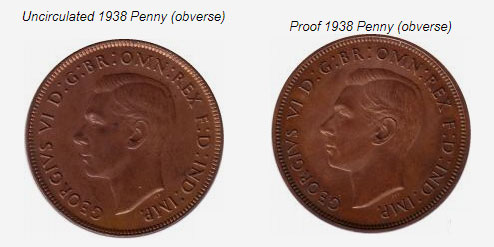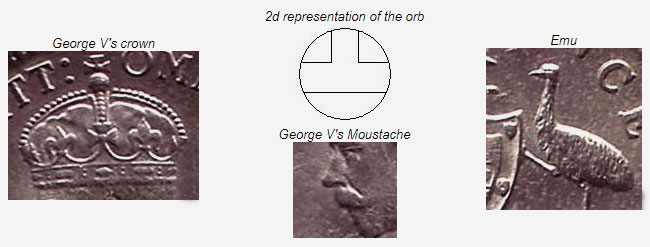Coin Grading Guide
By Walter Eigner | Saturday, 17 June 2006
One of those most difficult, yet paramount concerns for the coin collector is grading. To the collector this will help him find the best coin of his desired type for his collection. To the investor, this would mean he wouldn't need to rely on third party gradings from dealers, and with practice could confidently purchase coins off free markets such as eBay without having to fear finding out the coin has been over-graded two or three years down the track.
Introduction
Firstly, what is grading? A common misconception is that grading rates the appearance of the coin. This is not true; rather, it rates the level of preservation of the coin. Primarily, it concerns the amount of wear that the coin has received through circulation.
Quality of Strike
An important factor that must be first considered is, was the wear received through circulation? There are many ways an Uncirculated coin could have apparent wear. This could be caused through wear on overworked dies, through friction 'caused from coins rubbing up against each other in bagging and rolling processes, etc.

Observe the detail in the hairline, the prominence of the rim and legends in the proof example compared with the uncirculated piece. Even though the Unc piece hasn't seen a day of circulation, it has suffered from a slight weakness in strike which may, to the beginner, appear as wear. There is no definitive way of differentiating between wear that was caused during the striking process and wear caused through circulation, though there are some pointers.
- Weak Strike: observe other uncirculated coins of the same date. Usually strike weaknesses are common to a majority, if not the entire selection of the date. If most other unc examples seem not to possess the detail you're questioning, then it's likely to be a weakness in strike. If you don't have half a dozen unc examples of a particular date on hand, another method of identifying a weakness in strike is if the coin possess cartwheel lustre, look closely as you spin the coin and determine whether the cartwheel lustre goes over the point in question. If it does, then it's a weakness in strike. Unfortunately this only works on lustrous examples.
- Minting wear: as this is acquired in a similiar way as normal circulation wear, it is difficult to properly differentiate between this and normal circulation wear, and as such unless the coin is straight out of a mint roll, I tend to consider such as if it were normal circulation wear.
Toning
Though strictly doesn't affect the grade, it is usually considered in determining the value of the coin. On silver coins, usually a lovely even tone with good eye appeal may increase the value of the coin to the discerning collector, and of course, you can't go wrong with a coin in the original color presenting full blazing mint lustre. The most attractive coins in my opinion were always mildly toned with a strong degree of mint lustre prevailing beneath. On copper coins, however, usually untoned (red to orange) pieces demand significant premiums over toned examples.
Wear
Now down to the actual science of grading. It is impossible (or at least very difficult) to accurately grade a coin without first seeing an uncirculated piece.
Here is an Uncirculated, and exceptionally well struck example, being fully struck up except for the top of the shield and moustache. (observe how those features seem somewhat flat and undetailed).

Let's take a close look at George V's crown, but first some definitions are in order:
- Band: The two horizontal lines at the base of the crown
- Pearls: Those eight dots in between the two bands
- Center diamond: The diamond at the center of the bands
- Orb: The circle towards the the top of the crown.
The first three of these features are almost always complete on Uncirculated pieces (though some threepence tend not to have all eight pearls due to a weakness in strike). The orb in this particular scan is hard to see clearly. A complete orb will look similar to this:
The orb is not usually struck up fully and is not usually neccessary for an Uncirculated coin.
In addition, George V's moustache is weakly struck also, common to most threepence. On a perfectly struck coin, it should present a few hairlines through it.
In this particular example the emu is fully struck, with it's feathers extending to the neck region, rarely seen on threepence (though relatively common on this date). However, emu feathers are commonly weakly struck and if the coin you bought as an Unc doesn't display as much detail as this, don't fear, it's most likely suffered from a weak strike.
Grades and their Definitions
- Good - a coin in this condition with exhibit significat wear. All detail would be clearly identifiable, however lacking in detail. Legends will be clear and legible.
- Very Good - a coin in this condition will also have significant wear, though less of it. Detail will be slightly more evident and on George V coins, part of the band should be visible and 'Advance Australia' legible.
- Fine - a coin in this grade will have suffered from noticably moderate wear. The more intricate details should be apparent however the high points will usually be completely worn off. George V coins will possess full band on crown and a clearly legible 'Advance Australia'.
- Very Fine - a coin in this grade will have some wear, though not easily noticed. Many of the high points will have suffered from some wear, however most of the detail should be apparent. George V coins should display a full and clearly defined center diamond and 6 pearls in the crown. The emu should display a moderate amount of feathers.
- Extremely Fine - at this point the coin should be easily mistakable for an Uncirculated piece without close inspection. Detail should be clear and virtually complete with only the high points having some degree of wear. It should display a strong cartwheel lustre unless toned. George V coins should display a clear set of 8 pearls unless weakly struck. Emu feathers should be abundant. At this point only George V's moustache and the center of emu should possess actual circulation wear.
- about Uncirculated - an aUnc coin refers to a coin that is essentially in mint state, however with trace amounts of friction on the highest points of the coin. It could also, however, refer to a coin that has not experienced any circulation, however has suffered from a very poor strike or excess bagmarks (marks in the field 'caused during bagging of coins). Lustre should be prominent unless toned and appear complete though may be broken on the highest points.
- Uncirculated - exactly as the term describes, a coin that has not seen a second of circulation. It may not be completely struck, may contain one or two minor rimnicks and some bagging in the fields. However excess of any of these may neccessitate an about Uncirculated grade
- Choice Uncirculated - essentially a premium example of an Uncirculated piece. Such a piece will be free of rimnicks, with only a couple of bagmarks and should be virtually completely struck up.
- Gem Uncirculated - an Uncirculated coin that is perfect in all respects to the naked eye. It will not display visible imperfections in the fields and will be fully struck up. It however, may contain traces of bagging under a magnifying glass.
- Fleur de Coin - A perfect coin, both to the naked eye and otherwise. Usually reserved for proof coins and circulation issues tend not to be struck up to such a degree of perfection.
Sometimes a coin may not be quite a certain grade so it's neccessary to introduce partial grades. A coin that is considerably above Fine but not quite VF, would be given the grade about VF. A coin closer to Fine would be given the grade good Fine.
If the obverse and reverse grades differ, it is usual that you state both grades in the format, obverse/reverse. Eg a coin with a VG obverse and a Fine reverse would be given the grade VG/Fine.
Interpretting the Sheldon Numerical SystemThe Sheldon Numerical system is a numerical method of grading intended to be able to grade a coin right down to the last bagmark. Though it certainly can't achieve such, it definately offers some advantages over the adjectival system.
Here is a list of grading equivilents.
- VG = VG8
- Fine = F12
- VF = VF20
- EF = EF40
- aUnc = AU50
- Unc = MS62
- Ch Unc = MS64
- Gem Unc = MS66
- FDC = MS70
In addition proof coins receive the PR prefix. Partial grades get a raise in the number, such as gFine = F15, aVF = F18, etc. This system has been widely adopted within the American coin community and their third-party grading services. However you should be advised that their standards are quite different to Australian standards and in most cases the Australian standards tend to be 1-2 grades more conservative, in particular on sovereigns and halves. For example an EF40 third-party graded half soveriegn would probably grade closer to gF to VF on Australian standards.
I hope this article has helped you to grade coins more accurately and hopefully will aid you in your purchases over eBay. If there's one thing I can recommend, is that with every valuable coin you purchase off eBay, bring it to a trusted dealer to grade. Most will do this free of charge and hopefully will aid you in determining the level of each seller's own personal standards in gradings.



